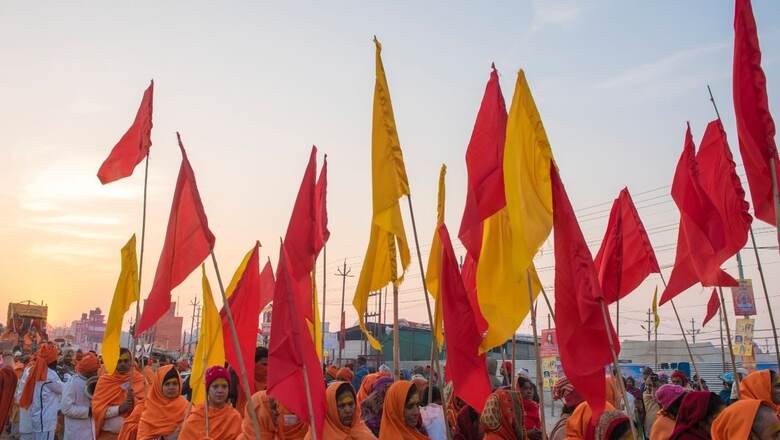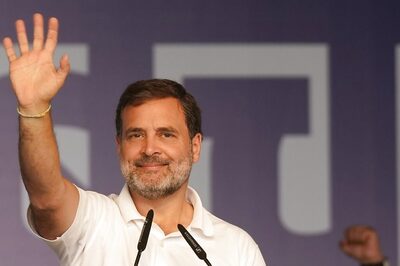
views
On the issue of refugees fleeing religious persecution in the Indian subcontinent, Joya Chatterji misrepresents blithely by making it apparently a phenomenon that overwhelmingly affects Muslims: “Until the end of the century, Muslims continued to leave India in waves, after riots and calamities such as the violent incorporation of Hyderabad in 1948 (in which between 25,000 and 40,000 Muslims died); the Hazrat Bal incident in Kashmir in 1964 and the violence of that time; the demolition of the Babri Mosque in 1992; and the Gujarat riots of 2002” (p. 403). Only adding, in passing, that Hindus had also left Pakistan and Bangladesh, though evidently they’re not commensurate victims. Joya Chatterji draws a bizarrely improbable parallel between India’s liberation of Hyderabad’s Hindus being terrorised by Razakaars, under the cruelly licentious Nizam, with Baluchistan’s accession to Pakistan under duress, when Jinnah’s army marched in to occupy the Baluch coastal towns of Pasni and Jiwani.
JC obsesses about any Muslim refugee camp she can unearth and the lives of Urdu speakers caught up in the cruel maelstrom of newly independent Bangladesh. Her fixation with their miseries, whether in the Town Hall Camp of Dacca, where Razakaar collaborators had been confined by Bangladesh’s new government in 1971, or the Muslim slum of an earlier era in Patwarbagan in Calcutta, is an exaggeration of actuality in the scheme of things. JC’s sustained portrayal of them is effectively the self-conscious obverse of repudiating the fate of Hindus as a result of Muslim violence and depredations and their infinitely greater scale and frequency.
But this parallels JC’s frequent adverse comparisons of Hindu social life and its alleged basis in extant law and custom with the supposedly humane practices of Islamic tradition and law, especially in relation to women’s property rights and divorce (e.g. p. 469-72). JC approvingly quotes hardline Muslim cleric, Maulana Thanawi, on the superior property rights of Muslim women (p.425-30). Her contorted apologetics shroud the gruellingly repressive upbringing so many Muslim women narrate compared with that of a Hindu. She implausibly avers that the notion of romantic love before marriage is apparently condemned and equated with lust by Dharmic precepts. One supposed authority she cites in this regard is Arundhati Roy, who makes a living slandering India.
The circumstances of the degeneration of aspects of Hindu society during a millennia of ruthless barbaric subjugations, when its holistic structures of an interdependent totality of social practice, legitimate political authority and overarching Dharmic injunctions ceased to exist, do not elicit any sense of empathy. She manages to deride Karva Chauth as an upper-caste penance when its pragmatic impact in strengthening mutual bonds of commitment happens to be its obvious social and human rationale.
The decimation of India’s Brahmins, increasingly cast to the winds, was a genocide initiated by Muslim conquerors, who viewed them as their principal opponents. Christian evangelists subsequently regarded them as the main barrier to mass religious conversion and instituted hatreds against them that thrive to this day in independent India, especially in southern India. The evangelist conspiracy succeeded, with the number of Brahmins in India, once the repositories of Hindu intellectual knowledge capital, barely double its 2% Sikh population (p. 545). JC continues to pile additional calumny on Indian social norms by failing to highlight that modern Indian law on homosexuality was a Victorian inheritance and its judicial prohibitions and sanctions absent in historical Indian custom and its practice accommodated in its ancient narratives.
Chatterji’s frequent references to the detrimental effects of Brahmanism and Sanskritisation are belied by the diversity she herself describes in ‘Miracle Play and Drama: Danger and Leisure’, in which the ancient history of local diversity in religion is evident. There was of course a high culture of philosophical ideas about ultimate truths, too demanding for even the most educated to grasp, but there has always been alongside it a wide variety of forms of worship. They derive from local reveries of what might constitute the divine, reachable through myriad forms of Bhakti. JC herself designates them as “transcendence, of mystery, of profound authority” (p. 625).
These social practices could be susceptible to degeneration and what others might view as superstition, but the quintessential issue is the absence in Hinduism of scriptural diktat, enforced by the threat of sanctions. On the degeneration of Hindu social practices, intellectual apologists of Islamic rule over India studiously avoid identifying their origins in the subordinate place of women in the culture of Islamic invaders. Two memorable instances are worth retelling, one of the disgust of a Muslim chronicler at Hindu husbands consulting wives and, second, their proclivity to wrap themselves around the husband’s body during intimacy.
The individual local Hindu imagination was not forced into predetermined rigid straightjackets, deriving from some allegedly incontrovertible and unalterable divine text. The free play, discovery and imagined caprices of interaction with a cherished natural world created a genuine basis for personal experience of life and divinity in Hindu society. This is surely the great, liberating strength of Hinduism, far removed from instrumental political control, which Semitic invaders found so alien and intolerable. The supposed spread of the high culture of so-called Hindu Sanskritisation, only touching a few, was a relatively benign process of acculturation.
By comparison, rural Europe remained barely Christian in its practices after fifteen hundred years of largely military triumphs to foist it on pagans. In the end, Christian orthodoxy still had to be imposed sternly to stamp out heresy. It was accompanied everywhere Christianity was triumphant by torture, authorised by an early Pope, human immolations and orgies of iconoclasm, destroying magnificent art objects. It might also be noted that Joya Chatterji’s account of the Ramayana story is self-consciously secular in tone, intentionally robbing it of its sacredness by insinuating violations of contingent petty modern fixations on caste, class and feminism by Lord Ram.
Chatterji’s discussion of ‘prostitution’ in India, enforced or otherwise, would have been more realistic had she contextualised it with the conquest of India by invaders. The seizure by Muslim conquerors of Hindu women, girls and boys as sexual slaves was the norm after any military engagement and kidnapping them when the fancy took any notable or local satrap. Upper caste women used to take shelter in Kolkata’s Fort William to evade abduction by roaming agents of the debauched eighteenth-century ruler of Bengal, Siraj ud-Daullah. The fate of Hindu women under Muslim rule was not vastly different from enforced ‘prostitution’ and one local Muslim Nawab had 16,000 women and girls locked up in his private ‘brothel’, provoking the jealousy of the emperor himself.
Another woman apologist of Islamic sexual slavery, Harvard faculty no less, once suggested enslaved harem ‘prostitutes’ could leave their slippers outside the door to indicate unavailability. It is not obvious if one should laugh or cry at this willful naiveté because the slippers obviously indicated menstruation because Ottoman rulers had uncooperative women sealed in bags and thrown alive into the Bosporus. The British too were not so very far behind in sexual frolicking in the empire and Ronald Hyam describes the empire as an occasion for sexual opportunity in his study (Empire and Sexuality: The British Experience – Studies in Imperialism; Manchester University Press, 1991). Yet, JC castigates the social practices of Hindu society at every opportunity although its practices had lost much of their traditional moorings and integrity under cataclysmic foreign conquests.
The kindest explanation of JC’s one-sided perspectives could be that she too is the quarry of an overpowering white metropolitan imperialist ideology. It seems to ultimately dictate what societal dynamics constitute normalcy, which curbs one’s ability to conjure an alternative vision. This is a phenomenon easy to recognize because it has taken me many painful decades of self-denial and unsparing self-criticism to overcome to a tolerable degree.
But there are indications that Chatterji’s instinctively hostile narratives about India, its ancient culture, institutions and somewhat dysfunctional state apparatus might have also been swayed by the agenda and politics of the CPI(M) (hinted at in p. 422). Its adoption of a destructive imbecilic worldview derives from the same Western ideological stable and its grotesque Sinic perversions. They have exercised an effective monopoly over key Indian university social science faculties in the decades after Indian independence.
This usurpation of India’s intellectual space, in conjunction with highly suspect and hostile foreign academic institutions and faculty, intensified owing to Mrs. Indira Gandhi’s dependence on the political goodwill of communists (p. 480). Mrs Gandhi ended up ceding control of humanities higher education to an essentially depraved communist political dispensation, thoroughly engulfed by radical Islam as well since its very foundation in India. It has managed to forestall opportunities for exposure of its untold misdeeds by misusing wily intellectual sophistry, organizational control and street muscle. These dreadful intellectual hoodlums, often of Oxbridge Ivy League provenance, easily outclassed the hoi polloi of India’s Sangh Parivar in the joust over narratives.
One is left wondering if the reason why some of the worst criminal acts of the CPIM do not even get a passing mention in JC’s otherwise hugely detailed account that encompasses many obscure events is a relationship with these Leftist political elements. The most unforgettable of such incidents include the mass slaughter and gang rapes that occurred in Marichjhapi, virtually on the orders of West Bengal’s CPM Chief Minister, Jyoti Basu, the cynical, soft-spoken politician with murder in his heart. It is also still astounding to recall the chief minister’s notoriously unmoved insouciance about the brutal gang rape in May 1990, by his party goons, of three young women health officers of his own West Bengal government and the UNICEF and the murder of one of them, Anita Dewan. Earlier, in 1970, at a place called Sainbari in West Bengal, thugs from the CPIM had forced the mother of two murdered sons active in the Congress Party to eat rice drenched in their blood.
JC’s wide-ranging survey of Indian life across much of its geographical expanse clearly indicates she is not oblivious to the new government’s circumscribed institutional capacity and the formidable practical barriers to even engaging with the great mass of India’s people, beyond urban conurbations. The authority and physical access available to the Indian state was barely superior to the Mughal empire’s writ, limited to the highways and cities of conquered territory. But she records the malign Narmada Bachao Andolan’s activities to halt a major development project without further elucidation, although the dam at issue transformed much of Gujarat for the better (p.611). JC’s carping criticism of the low nutritional content of India’s important midday meal programme for schoolchildren fails to mention a growing recourse by state governments to its high-quality provision by the remarkable Akshay Patra.

Some state governments elected by dominant Muslim constituencies and their Christian evangelist allies have been trying to derail food provision by Akshay Patra by citing bogus reasons. However, JC herself may find Akshay Patra’s refusal to use onion and garlic in their cooking a product of the usual Brahminical caste machination (p. 614). On JC’s scepticism about India’s valiant efforts to overcome food deprivation, JC was not to know, that one of its critics, the crusading journalist she approvingly quotes on the acknowledged problem of malnutrition, P Sainath, would turn out to be a paid Chinese stooge. Although he is surely one of her motivated choleric fellow travellers. The breathless awe in which many dupes have held China’s contrasting progress since 1978, including the omniscient Amartya Sen, Master of Trinity, JC’s alma mater and academic home, is remarkable. The monstrous socioeconomic experiments of Chinese communism are now coming to grief across multiple fronts, not least owing to its imperialist belligerence.
A privileged background in urbane anglicised academic instruction, enjoyed by many of this urban Left-liberal academic cabal, is also reflected in the lyrical prose and alluring idiom with which Joya Chatterji depicts her extensive excursions into the traditions and social life of India. There is considerable evocative reflection by JC on Indian society. She explores everything, from street food and the railway breakfast, the experience of India’s overcrowded public transport to its varied regional social cultures and the captivating capers of India’s itinerant circuses, acrobats and magicians, its baazigars. There is an eccentrically thorough discussion of the significance of wrestling, kushti, in Indian society and the widespread existence of akharas and their association with nationalist sentiment. For some wrestlers, their sport was an obsession akin to Nabokov’s butterflies, rendering much else in life somewhat humdrum (p. 658).
JC writes knowledgeably about Indian dance, folk, classical and Bollywood and how they came to be synthesized as well as their origins in earlier traditional forms in temples and courtly culture. It was apparently denounced unsparingly by Keshab Chandra Sen of the Brahmo Samaj as licentious beyond redemption. The discovery of an ancient Sanskrit text, Natyashastra, and its full publication in 1890 is an interesting episode on how a classical tradition was restored and Bhartnatyam rescued and revived by the remarkable, Rukmini Devi although Joya Chatterji believes the claim of association with ancient spiritual tradition contrived. A comparable role was played in the Kathak form, a debauched nautch dance routine earlier, by the formidable Kapila Vatsyayan, another successful promoter of ancient Indian high culture. However, Kathak retained its hyper-sexual hybridity in the murjaa through its renowned exponent, Birju Maharaj.
JC’s exploration of the lives of various classes of Indians, the wealthy, the middle class and the poor, is also coherent and appealing. It poignantly captures the kaleidoscopic quilt that has comprised India, throughout the twentieth century and beyond (e.g. on the middle and business classes (e.g. p. 569–582). Despite the display of prodigious learning JC’s extended account is not particularly sympathetic towards its Indian subject, coloured, unsurprisingly, by an unspoken ideological aversion for the inevitably quirky though largely innocuous social practices that usually typify human relations.
Chatterji inexplicably identifies the remarkable Mumbai dabbawallah phenomenon of delivering home-cooked food to office-goers as a means of preserving caste purity, which is the reason she oddly suggests for children carrying water bottles to school as well. JC also seems to have an incongruous antipathy towards vegetarianism, as a preference deriving from Brahmin avowal of caste status although the health and ecological drawbacks of consuming rice she stresses were indeed recognised more than a century ago (p. 590-8). However, on the wider issue of Indian identities, JC does recognise the farcical introduction in the nineteenth century of imported English legal dogmata to interpret Hindu family life, described memorably by a British judge as a ‘phantom of the brain, imagined by Sanskritists without law, and lawyers without Sanskrit’ (p.464-591).
Chatterji devotes an overlong but perspicacious section to the Indian film industry, dominated by Bollywood, its precarious political economy, chaotic organizational dynamics and the role of great directorial innovators, actors and actresses. She also ends the book with an interesting discussion of individual Indian films, though her interpretation is often unconvincingly political. The salience of the cinema, like cricket, in Indian life cannot be denied, capturing the attention and emotions of a vast mass of humanity.
Viewers indulge in a few hours of fanciful entertainment punctuated by stirring romance, the violent downfall of ‘baddies’ and nuanced subversion of tradition. It offers the luxury of escape from drab lives and often straitened circumstances. Despite JC’s liberal moralising disquiet about it, why the supposedly respectable woman avoided an acting career is understandable. The industry’s reputation for depravity and exploitation of women aspirants to an acting career is increasingly being laid bare by growing revelations, which leaves little to the imagination.
Before the era of mass audiences, films usually had a storyline and themes were didactic, articulating social realism and nationalism. They were to be succeeded by entertainment for mass audiences without truly credible plots, but much action, dance and drama though social issues were also evident. As audiences enlarged and became more diverse, films with complex plots also emerged and a whole new genre, exhibiting higher cinematic standards and with serious aesthetic pretensions, have followed. The historic filmmaker Satyajit Ray was less an Indian director than a ‘European neorealist’ of remarkable sensitivity who addressed Indian themes. In fact, India’s pioneer filmmaker was an ancestor of mine, the brother of Dinesh Chandra Sen, not Dadasaheb Phalke. Unfortunately, all his film reels, bar one, were incinerated by his brother in a fit of rage.
JC understandably ignores how India’s film industry acquired an Islamized ideological undercurrent disavowing India and its Hindu culture, eventually becoming a recurrent dominant theme, as studies have shown. In recent years, a veritable backlash has been occurring against the contemporary amoral, drug-fueled and reflexively crude anti-Hindu popular Bollywood film. Its underworld criminal and Pakistani connections, also mocking Indian institutions, like its armed forces, a reason for growing public anger.
One gets the sneaking suspicion that JC’s extraordinarily adulatory view of Bollywood stems from her ineffable sympathy for all things Muslim since their dominance over the Bollywood industry is evident from her long discerning account of its history, in all its dimensions. Bollywood’s immense influence on Indian public consciousness increasingly became a harmful challenge to its sense of nationhood and cultural integrity. But that is now coming to a close in the new India that is Bharat, which JC characterises as ‘communal hatred for Muslims’ (p. 767). However, JC triumphantly contends the influence of Bollywood is a welcome subversion of traditional culture and an alleged articulation of what some describe as ‘composite culture’.
Chatterji’s formidable and readable but deeply flawed account of 20th-century India is a salutary reminder of the external impact of Western intellectual life, books, universities, journals, think tanks and its media and newspaper editorial pages. Such endeavour is not engaged in autonomous activity with its own aesthetic integrity and inner intellectual logic. They are an aspect of the wider societal engagement of the West with the vanquished world of the Other. This wider interaction is not benign despite its innumerable nuanced manifestations that may mitigate and soften the perception of its real principal impact. Ultimately, this impact is political and defined by adversarial relations of conquest and subjugation of other nations and cultures. This is the preponderant expression of the totality of the Western intellectual world and regularly comes to life with unabashed shocking clarity.
The most important aspect of the entirety of Western intellectual life and culture is its rootedness in a Christian past. It’s the ideological Christian past of advancing European military and political conquest of other societies and cultures that is the real historical parallel for the contemporary externalisation of the West’s intellectual life. The goal is to subvert the independent thinking of objects of domination by overwhelming them intellectually with the weight of a compelling and plausible account of the natural order of things. As an aside, it might be noted that almost all novels written by Indians for an English-speaking audience are unavoidably absorbed into the Western project to control the intellectual lives and thoughts of the Other, like Indians. Some Indian writers cater rather shamelessly to existing Western prejudices in order to vindicate them and find buyers for their creations. This is an intellectual genre to which Joya Chatterji’s historical oeuvre also belongs.
Western academia and its exultantly malevolent media are crude arms-length instruments of foreign policy. They are mostly co-conspirators in the unrelenting psychological warfare against former European colonies and Russia too. This reality is resoundingly confirmed by their unwavering collective participation in the crude propaganda war over Ukraine. As a result, virtually everything also written by Indian social science and humanities mercenaries abroad, their loyal camp followers in Indian institutions and the Western media is ideologically inspired and strains to cast Pakistan in a favourable light.
Of course, Pakistan has been a vital Western ally against Soviet communism and a calculated terrorist millstone around Indian necks. In addition, it has been the supplier of soldiery for mobilisation to subvert Arab struggles for freedom and unity. The inevitable corollary of this geopolitics needs to necessarily denounce post-1947 India and all its evil works and any civilizational claims it has the temerity to advance.
Like so much writing on objects of colonial scorn and targets of despoliation, Joya Chatterji’s approach to India has an ontology, but eschews epistemological analytical rigour, but it does have a self-consciously ill-disposed methodology. The ontology is an unspoken apologia of disdain for India and Hindus and the intellectual integrity of scrupulous epistemological procedures, like logicality and empirical validation, are cast aside. The methodological equivalent of a metaphorical magnifying glass is applied to underscore every inescapable Indian shortcoming, not how a subject deserving compassion is scrutinised. A face examined with a magnifying glass will highlight every blemish and they can be represented as defining it instead of a more rounded benign picture of it, viewed from a distance.
Sadly, the once great civilisation of the Hindus and the history of awe-inspiring intellectual sagacity are no longer equal to the task of disavowing the ongoing warfare of Western mind games. The colonial-origin vilifications are articulated by historians and scholars who question the very integrity of Hindu civilisation, echoing the imperial evangelist calumny of an earlier era. Thus, some contemporary Hindutva claim that the improbable status of Vishwa Guru is merely an embarrassment.
Joya Chatterji has strained resolutely throughout to show Hindus and India in a poor light, unsympathetic as well to India’s impossibly difficult task of creating and building a nation after millennia of comprehensive demolition by cruel British and worse Islamic rule. By contrast, she is exceedingly parti pris in her depiction of subcontinental Islam and Pakistan in a positive light, ignoring the horrors suffered by Hindus in their hands. It might be suggested that since Chatterji is so infatuated with India’s film industry and Bollywood, she would have been well-advised to have restricted herself to writing its history. The India she has written of so tendentiously is now defined by Subhas Chandra Bose, Veer Savarkar, and Vallabhbhai Patel, the men she finds thoroughly unpalatable and it is timeout for colonial historical writing.
(Concluded)
The writer taught international political economy for more than two decades at the London School of Economics and Political Science. Views expressed in the above piece are personal and solely that of the author. They do not necessarily reflect News18’s views.




















Comments
0 comment